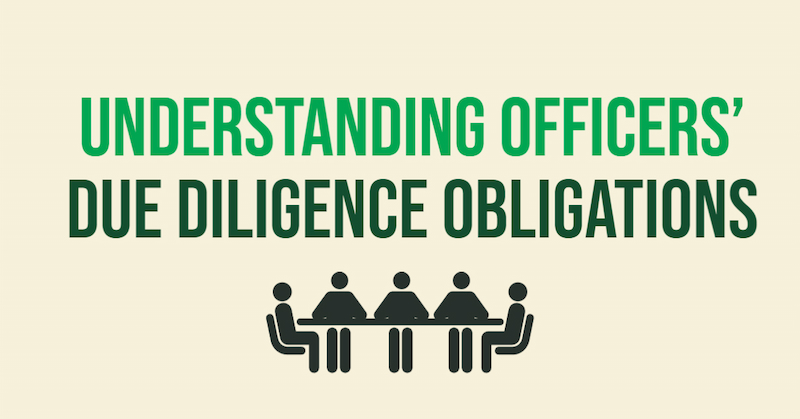When it comes to health and safety, sometimes we all get caught up in the how, and forget to do our homework on the what and why. We’re all too familiar with the idea that we need a strong safety culture that empowers employees to speak out, and take control over their own safety.
However, what are the costs of not doing this?
There are several hurdles to overcome, long before a safety culture can settle in - namely, due diligence obligations. While it's common knowledge that an organisation has legal health and safety compliance requirements, the extent of an officer's involvement is not always well-known.
Many officers aren’t actually aware of how much they need to be in the know about the state of their organisation’s health and safety. Instead, there's often a lot of reluctance from the top-end to engage fully with health and safety and approve investments in appropriate equipment, software, and resources.
It’s important to take a deep dive into the legislation and unpack what the requirements are for both officers, and health and safety leaders in the organisations. Examining what’s needed creates greater clarity and paves the way to justify investments in better health and safety architecture throughout the organisation. The end result? Initiatives like a strong safety culture are backed by the board at the top, and are a lot more effective.
Get fresh H&S insights weekly
What’s an officer and what’s their role in WHS?
An officer holds a specific role that allows them to exercise significant influence over the managerial decisions of the business - company directors, board members, CEOs - those at the top of the hierarchy tree. Other members of the senior executive team can also be officers.
Their due diligence duty is clearly defined in the Model Work, Health & Safety Act in Australia, and the Health and Safety Work Act in New Zealand (if you need to take a closer look).
In a nutshell, officers must take proactive measures to ensure that their organisation is meeting health and safety requirements. They don’t need to be experts in the health and safety field, or memorise every single statistic from the past five years, but they do need to have an actionable, proven interest in the health and safety of their workers.
Beyond just implementing health and safety checklists in a weak attempt at legal compliance, officers actually have to be proactive, having conversations about the underlying reasons behind recurring incidents, with a willingness to address the issues and take action to prevent them happening again.
In other words, the health and safety leader cannot be shunted away working alone to improve workplace safety - rather, they should be working in tandem with the organisation’s officers. This is a critical point; many officers might be falling short here with a ‘tick-box’ mentality instead of a proactive approach.
.jpg?width=800&height=419&name=health%20and%20safety%20due%20diligence%202-1%20(1).jpg)
What is an officer’s duty to H&S in their organisation?
The PCBU or organisation primarily needs adequate systems that ensure the leaders can actively monitor and evaluate both the current status and management of their health and safety. In doing so, the officer is legally required to take reasonable steps to continually learn and keep up to date with any work-based health and safety issues. If things go wrong, enforcement can happen if the officer can be proven to have not taken effective systemic action or met their duties.
Furthermore, they need to take reasonable steps to continually learn and keep up to date on work H&S issues. OFficers also need a comprehensive understanding of the work of the PCBU, specifically how the risks workers might face will appear. The officers also need to check that the PCBU has adequate processes in use, that help to eliminate and minimise risk. The officer also needs to communicate effectively, and also understand, consider and respond to health and safety information.
If the officer fails to do any of the above and things go wrong, they could face prosecution. Most notably, this will occur when there’s evidence of systemic failure within the organisation and a failure of the officer to meet their duties.
How health and safety investment benefits the business
While the extent of the officer’s duties might sound slightly foreboding, bear in mind that the officer does not need to be an expert in health and safety - that’s the health and safety leader’s job. The officer simply needs to engage in conversations to learn about their organisation's status, and be proactive in creating systemic solutions.
If you’re a health and safety leader trying to get buy-in from the top, remind your officers that, beyond the legal due diligence requirements, investment in health and safety ultimately only can benefit your organisation. From preventing employee disruption in their day-to-day work, to increasing worker motivation and satisfaction and preventing time-wasting, health and safety investment goes a long way.
How can health and safety leaders assist their officers?
The following outlines four key steps a health and safety leader can take, to ensure that the board and officers are meeting their due diligence responsibilities at a governance level.
1. Have a formal health and safety governance plan.
All organisations should start by debating, and creating a formalised plan/long-term strategy that can act as a lens for all business decisions, and guides the business forward. This health and safety plan is also a document that demonstrates the officer’s commitment to their organisation's health and safety, fulfilling the first criteria of their due diligence.
This is most effective when all parties - management and workers - are involved in the creation of this policy. In doing this, it has the power to influence real change and plant the seed for a strong safety culture.
2. Set clear targets, goals and objectives.
As part of this above governance strategy, all organisations must set clear targets that are measurable, to help achieve their strategic vision. Data becomes meaningful when it can be compared with targets, helping to establish progress in health and safety in the workplace.
3. Ensure that the board structure is inclusive of health and safety
The board should be structured in such a way that ensures that at least one officer has in-depth knowledge and experience with health and safety requirements, so that the organisation has the right people at the helm.
There might be an assumption that most officers have some background knowledge or degree of experience with health and safety, but this isn’t enough - a board needs an individual who can hold their fellow officers accountable and ensure they meet their due diligence requirements.
4. Provide the CEO with health and safety responsibilities in their job description
In both the performance plan, and the CEO’s job description, their health and safety responsibilities should be clearly stated so that the CEO will walk the walk.
No front-line workers will be motivated to fully engage with health and safety best practice, if their leaders aren’t setting the example. If the leader’s responsibilities are outlined from day dot, their role actively includes health and safety.
For a health and safety leader, having a CEO that champions your work gives you the best possible environment to reach your full potential.
Final words
While officers always have a lot on their plate, and their work cut out for them, their health and safety responsibilities cannot be left unattended.
Far from being left in the dark about what's going on in their organisation's health and safety, officers are legally required to be part of the planning committee - that is, getting stuck in the middle, with total transparency about what's going on.
While understanding due diligence may not be news for everyone, it's always worth having a refresher to check how your leaders are holding up, and remind them about what their role needs to be.
Health and safety leaders can have a valuable role to play in assisting their officers to meet their due diligence requirements, and can transform their organisations safety systems.
If you want to learn more, click here to watch our in-depth webinar, where expert Craig Bleakley dives into due diligence 101.




.png?width=352&name=Copy%20of%20RETAIL%20SAFETY%20(2).png)

.jpg?width=352&name=AI%20health%20and%20safety-1%20(1).jpg)

